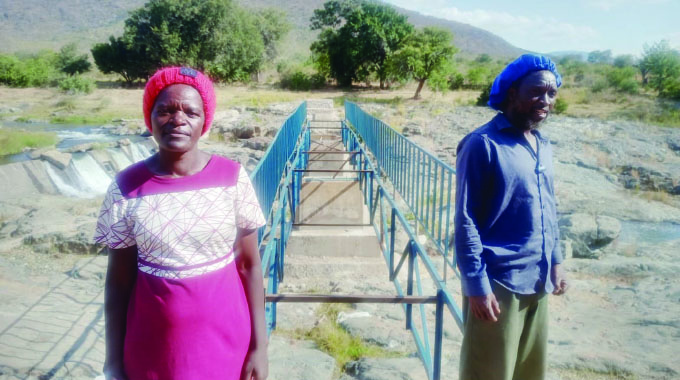A foot bridge: More than a crossing for Chimanimani community

Sifelani Tsiko Agric & Innovation Editor
Miriam Kuretu, 44, of Bvumbura B village in the Shinja Ward 9 area of Chimanimani District in the eastern part of the country has in her life seen scores of people being swept away along the flooded Nyanyadzi River due to lack of a safe river crossing point.
Apart from the death of school children and other people, Kuretu has also seen, firsthand, how a flooded river severely disrupts livelihoods and impacts on the health of pregnant women and children.
Lack of safe river crossing has inflicted pain on her community with enduring impact.
“When Cyclone Idai hit our area in 2019, three people from our area were swept away and never found. Our children never went to school for three months because Nyanyadzi River was flooded. We were simply cut off from the outside world and we could not access our clinic, business centre and markets for our crops,” she said.
“Women with labour pains who needed to give birth at Shinja Clinic were the most affected and had to rely on “ana Mbuya Nyamukuta” — local midwives to deliver.
The local village health workers lacked adequate health accessories and water to assist the women.
“It was so painful to watch the women suffering without any access to proper health care at Shinja. There was despair and each time floods came we became destitute here.”
The old pedestrian bridge was swept away by Cyclone Eline induced flooding in 2000 and since then, people in the Shinja area of Chimanimani are periodically entirely cut off from their schools, clinic, business centre and the outside world.
What could be a rippling stream along the Nyanyadzi River in the dry season turns into a raging river during the rainy season which runs from November to March or April every year.
In Chimanimani, the vast majority of smallholder farmers live in rural areas with challenging, mountainous terrain.
During periods of seasonal flooding people in this part of the country are often cut off from schools, clinics, business centres, markets and other income — generating opportunities.
But now things are changing for the better for the Shinja community.
Following the devastating effects of Cyclone Idai and Covid-19 pandemic, Practical Action is implementing the 15-month Resilience Building for Chimanimani Communities (RBCC) project, funded by the United States Agency for International Development (USAID) that aims to support affected communities to enhance their agricultural production, improve livelihoods through incentives for households working in gully reclamation and other community infrastructure.
The programme also aims to support those participating in internal savings and lending schemes and to strengthen community’ response to climate hazards through early warning systems.
Through the Flood Resilience Measurement for Communities (FRMC) project, Practical Action is helping the Shinja community to build a US$36 000 suspended foot bridge to enhance its access to markets, schools, clinics and other services.
Construction of the new foot bridge started in December 2022 but the process was slowed down by the flooded Nyanyadzi River. It is now expected to be completed in June this year.
Work on the construction of the foot bridge is now about 80 percent complete.
This facility will serve more than 141 farmers who have to cross Nyanyadzi River to work at their Nyabande Irrigation Scheme as well as more than 480 school children and 3000 people in the ward.
People from Zimunda village regularly cross the river to access Bvumbura Business Centre at Shinja, Shinja Primary School, Shinja Clinic and Chinotumenyere Secondary School.
This infrastructure project, though small and less impressive in size and scope will have greater personal impact on the lives in the community here.
Councillor Lazarus Mauka (48) of Ward 9 Shinja, about 43km west of Chimanimani town, said the foot bridge will serve five villages — namely Zimunda A and B, Bvumbura A and B and Matiashe — all under Chiefs Mutambara and Muusha.
“In the past we have lost school children who were swept away trying to cross the flooded Nyanyadzi River. We are so excited about the support we have received from Practical Action and its partners to construct the foot bridge,” he said.
“The footbridge is going to save lives, increase agricultural production, improve the pass rate of our children in schools and enhance health care access for pregnant mothers and children.
“I am so confident that we are going to reduce deaths here when natural disasters such as floods strike. There is no road network across the river here and more people will now access markets and other important services.”
Since 2000, the Shinja community has been living without a safe river crossing.
Day Muresherwa (45) of Zimunda village said: “We need this bridge because we need to cross to work at Nyabande Irrigation Scheme. Weeks can go by without anyone being able to cross and people have died trying. We have demanded a bridge like this for a long time and I am so happy that our prayers have been answered now.
“I am so certain that our children are not going to miss school, that women in labour will deliver safely at Shinja Clinic and that production at our irrigation scheme will improve significantly.”
Muresherwa is so confident that when the suspended pedestrian bridge is completed, it will help children arrive safely to school and give the community better access to their fields, markets and medical care.
“We are so grateful for the support. I am so keen for this project to be completed soon. We want to save lives and enhance our livelihoods. This is much more than a bridge and the benefits are many for us,” he said.
Practical Action climate resilience officer Nkosiphile Mthethwa said the 70 metre foot bridge had created 16 jobs for locals and will enhance access to schools, clinics, markets and other critical services for the community.
“The Flood Resilience Measurement for Communities (FRMC) project aims to strengthen the resilience of the Shinja community to climate shocks such as floods. I am optimistic that this foot bridge will eliminate rivers as barriers to road networks and access to important services such as clinics, schools, business centres and markets for our smallholder farmers,” he said.
“Constructing footbridges costs a fraction of what it does to build and maintain vehicle bridges and other major infrastructures. This footbridge, small as it is, can improve livelihoods, increase household incomes and enhance access for this community to other major services they need.”
He said the foot bridge would also have other spill-over effects on wages, agricultural technology adoption, food security as well as health and educational outcomes in villages on both sides of the rivers.
The community contributed labour for the bridge construction as well as other locally available materials needed for the works.
Southern African countries that include Zimbabwe, Mozambique, Malawi, Madagascar, Mauritius and other small island nations located in the Indian Ocean are no strangers to tropical cyclones.
Climate change impacts are increasingly being felt more in this region, endangering millions of people.
In Chimanimani, Cyclone Idai led to 251 deaths, 183 injuries and 354 hospitalisations, while 1 654 people were internally displaced.
The cyclone also resulted in the destruction of over 10 irrigation schemes. This led to the disruption of agricultural activities and rural livelihoods. Over 347 km of road networks in the district were rendered unusable for months.
This affected people’s access to markets, disrupted their livelihoods and access to health care.
Tropical storms have caused severe humanitarian impacts in Madagascar, Mozambique, Malawi and Zimbabwe including deaths and injuries, infrastructure damage and a range of long-lasting socio-economic impacts.
Southern Africa now experiences about 10 storms or cyclones which travel across the south-western Indian Ocean every year during the rainfall season that runs from October to April. Tropical storms have destroyed homes, crops, bridges and roads bringing untold hardships to the affected communities. In some cases, tropical storms have cut electricity supplies causing blackouts in some countries in southern Africa. The recovery processes have not been easy in most of the countries, with some still reeling from the impact of Cyclone Eline of the 1999- 2000 rainfall season.
The most damaging tropical cyclones of the past few years were tropical cyclones Idai and Kenneth, which hit Mozambique especially hard in March and April of 2019.
Tropical Cyclone Idai, the worst in more than 50 years, brought heavy rainfall and strong winds to Malawi, Mozambique and Zimbabwe between March 5 and 19, 2019, causing severe flooding which led to loss of lives, destruction of infrastructure, disruption of livelihoods and destruction of crops.
Idai alone killed more than 1 500 people in Mozambique, Malawi and Zimbabwe.








Comments